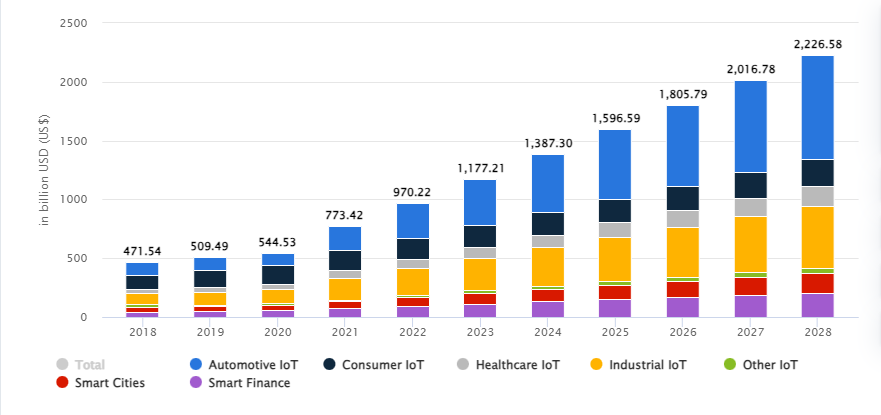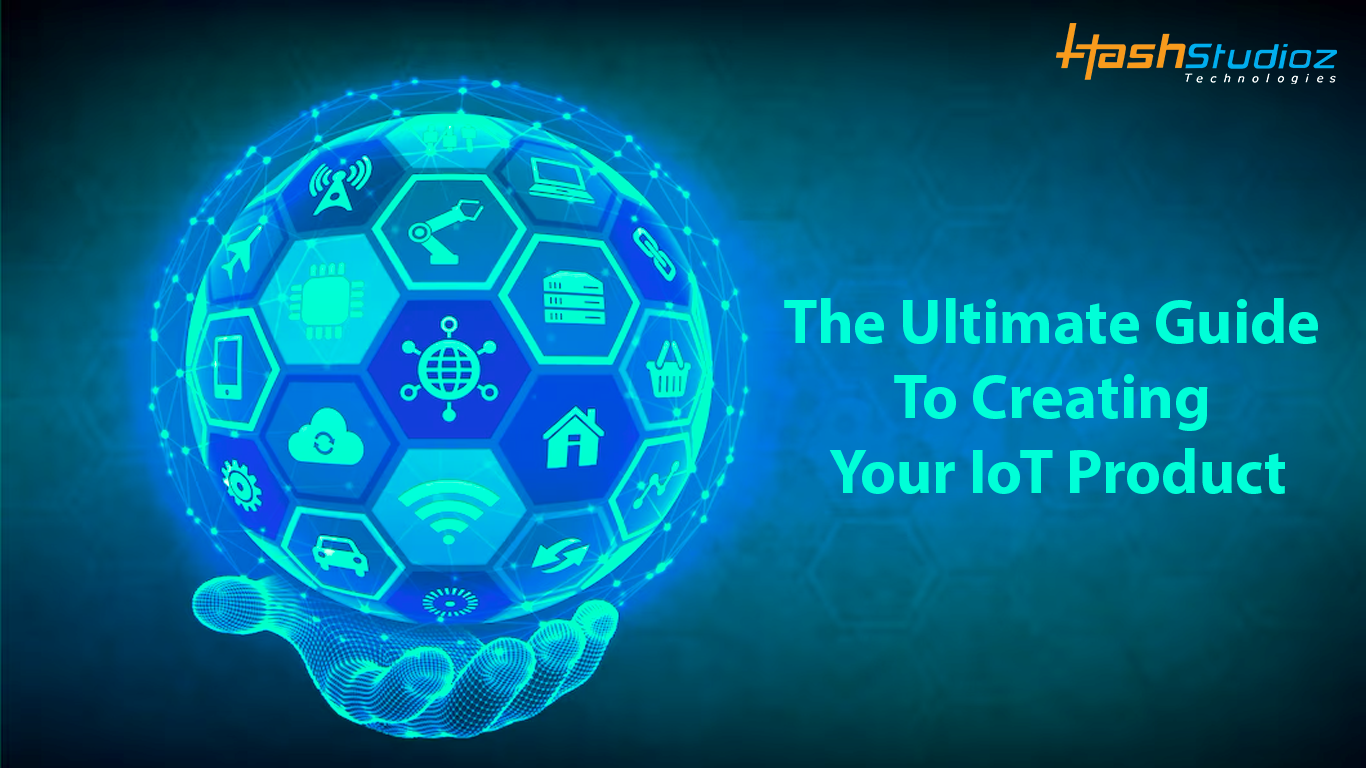The Internet of Things (IoT) is a rapidly growing technology that is transforming the way we live and work. By connecting physical objects to the internet, IoT devices can collect and share data in real time. IoT devices can help businesses to automate processes and save money on labor, improve efficiency and productivity, increase safety and security, collect and analyze data to make better decisions, and provide better customer service.
The global market for IoT is expected to grow to $2226.58 billion by 2028. This growth is being driven by the increasing demand for connected devices in a wide range of industries, including manufacturing, healthcare, retail, transportation, energy, and smart cities.
Global IoT Market Forecast:

Source: Statista Market Insights
As the IoT market continues to grow, businesses that are able to adopt this technology will be well-positioned to succeed in the future.
Table of Contents
The Importance of IoT in Today’s Market
The Internet of Things has become increasingly important in today’s market due to its ability to revolutionize various industries and enhance our daily lives in numerous ways. From improving efficiency and productivity to enhancing customer experiences and enabling new revenue streams, IoT has the potential to transform the way we live and work. By developing smart devices and services that carry out our daily tasks, IoT enables us to automate processes, gather and analyze data, and make informed decisions in real time.
Here are some specific examples of how IoT is being used in today’s market:
Manufacturing: IoT products are also being used in industrial settings to improve efficiency and productivity. For example, to track the location of products, monitor equipment performance, and predict maintenance needs.
Healthcare: IoT devices are being used to monitor patients’ vital signs, track medication adherence, and provide remote care. For example, wearable devices can be used to track heart rate, blood pressure, and other vital signs.
Agriculture: IoT products are being used to improve crop yields and reduce water usage. For example, IoT products can be used to monitor soil moisture, track crop growth, and control irrigation systems.
Transportation: IoT devices are being used to monitor traffic conditions, track vehicle performance, and improve safety. For example, IoT products can be used to track vehicles, monitor traffic conditions, and optimize routes.
Energy: IoT devices are being used to monitor energy usage, optimize grid operations, and reduce emissions.
These are just a few of the many potential future applications for IoT products. As the IoT market continues to grow, we can expect to see even more innovative and disruptive applications emerge.

Unlock the Full Potential of the Booming IoT Industry
It depends on where you are in the process. From idea to commercialization, this guide will help you every step of the way. We will follow the same simple three-step process we use at HashStudioz: Plan, Build, Scale.
1. Put a plan together
Develop a strategy
Are you targeting a specific market? Competitive analysis and market research are necessary for understanding the environment.
Gain a deep understanding of the target users and their pain points. This understanding will help guide the development of a product concept that effectively solves their problems or fulfills their needs.
Create a roadmap
To effectively plan your roadmap, consider the features your customers desire, not just what you want. Prioritize them by assessing their impact and development efforts. A helpful approach is assigning points to each feature based on this assessment. After scoring each feature, sort the list, and you’ll be headed in the right direction.
System architecture
It is important to understand the pieces that make up your IoT solution, just as you do with your strategy and roadmap. Most IoT products include hardware that collects data, a backend infrastructure that routes and stores data, and a web application that configures them.
If you’re not sure which tech stack to use, do your research and consult with experienced professionals. Various opinions may exist, but weigh the options since your technology choice will have downstream consequences.
Development strategy
How will you build your product? Choosing the right team from the beginning is crucial, and you have to decide whether you will build a team internally, outsource to a development partner (like HashStudioz), or do a hybrid of both. Working with the right team will pay dividends in the long run, so prioritize experience over cost. A product’s early days are like building a house; if shortcuts are taken when laying the foundation, your platform’s integrity will be compromised.
Also Read: What Are Some Tips To Choose The Best IoT Development Company?
2. Building your product
Minimum Viable Product
Honestly, building custom technology may not always be a good idea. In most cases, you shouldn’t. You’ve heard it again: “Build a Minimum Viable Product” to get early feedback. There’s a reason this statement is thrown around so often because it’s true!
The creation of an MVP is easier in software development, but that doesn’t mean electronics can’t do the same. You can get started with many Off-the-Shelf (OTS) products.
This is called a Proof-of-Concept (POC). Regardless of how it looks, you must prove that your idea works. If you’re thinking of getting into the hardware industry, it’s better to know sooner than later if it has legs.
By performing this POC, you can validate that you can collect data points. What is the desired flow of the data? How would you like to visualize the data?
By this point, the backend infrastructure should also be built. Although it will not be fully featured, it should be adequate for now as long as it provides the basics.
Prototype
As soon as you’ve received some validation and are confident about the path forward, it’s time to iterate. It does not mean you should build custom hardware right away. PCBs require a considerable amount of investment when it comes to designing and developing custom electronics. Therefore, you should reserve those resources until you are sure the time is right.
This next iteration might involve moving from a Raspberry Pi to a commercial Single Board Computer (SPC). Depending on your unique situation, it will vary. Early in the product development cycle, get your product in the hands of customers to gather feedback.
Ideally, you should have at least a barebones web application that helps you manage and configure IoT devices. Visualizing the collected data will also help you avoid manually querying the database.
Production
Now is the time to put all your learnings into practice and develop a product that is ready for production. It is also called commercialization. Choose a reputable PCB layout designer and contract manufacturer to manufacture your custom PCBs. Small-scale runs are typically better manufactured locally, whereas large-scale runs may be more cost-effectively manufactured overseas.
3. Scaling your product
Infrastructure
Dream big. Will your system be able to handle millions of devices or users? Scaling your backend infrastructure should be possible. Don’t let it become a bottleneck.
DevOps and Product Management
You may have been using a simplistic development process up to this point. Scaling, however, requires implementing the right git flow and Continuous Integration / Continuous Deployment (CI/CD).
You will be able to collaborate better with your team if you follow Product Management practices such as Sprint Planning, Daily Standups, and Retrospectives. By dividing large pieces of work into smaller ones, you will be able to develop more quickly.
Manufacturing
At this point, it may make sense to explore contract manufacturers overseas. Ensure that Intellectual Property (IP) is protected to the maximum extent possible. By sharing PCB layouts and keeping firmware source code in-house, you can achieve this.
Conclusion
Developing a successful IoT product requires meticulous planning, dedication, and a deep understanding of the market and your target audience. Smart cities will utilize IoT for efficient infrastructure management, energy conservation, and public services. Healthcare will benefit from remote patient monitoring and personalized treatment. In agriculture, IoT will optimize farming practices through precision agriculture. The industrial sector will witness enhanced productivity, predictive maintenance, and supply chain optimization. Moreover, IoT will pave the way for smarter homes and wearable devices, promoting a more connected and convenient lifestyle for individuals.
You should be able to bring your IoT product to life by following the above steps. Creating a successful product involves many small details, and it is impossible to list them all.

Frequently Asked Questions
1. What is a Minimum Viable Product (MVP)?
An MVP is a product with the minimum features necessary to be released to customers. It is a great way to validate your idea and get feedback early on.
2. What are some common mistakes made when developing IoT products?
Some common mistakes made when developing IoT products include:
- Not planning properly: This can lead to delays, cost overruns, and a product that does not meet the needs of the market.
- Not validating the idea: It is important to get feedback from potential users early on to make sure that there is a market for your product.
- Not choosing the right technology: There are many different technologies that can be used to develop IoT products, and it is important to choose the right ones for your specific application.
- Not securing the data: IoT products often collect and store sensitive data, so it is important to take steps to secure it.
- Not scaling the product: It is important to plan for scalability from the beginning so that your product can grow as your business grows.
3. Where can I find assistance in developing my IoT product?
If you need help with developing your IoT product, you can contact HashStudioz to schedule a consultation and explore how they can assist you with the best IoT product development services.

